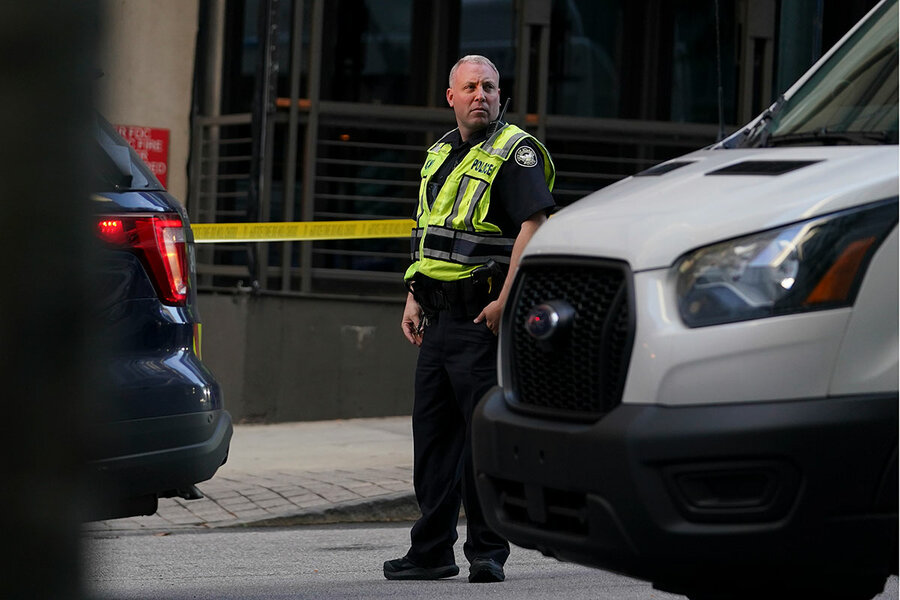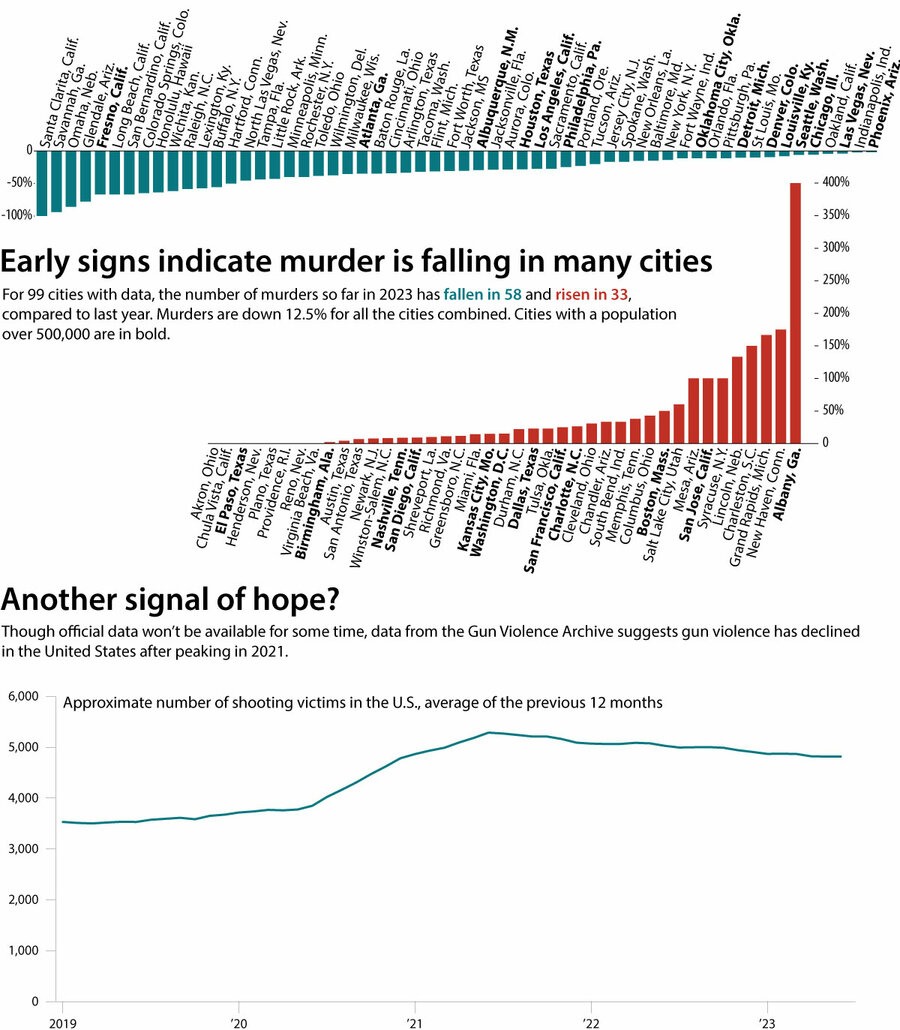What is behind a huge drop in the murder rate this year?
Loading...
| Atlanta
One researcher calls it one of the largest annual shifts in the murder rate ever recorded. In more than 90 American cities, murder is down 12% this year. New York’s murder rate is down by 13%, and shootings in the city are down by 26%. Jackson, Mississippi; Minneapolis, Minnesota; and Little Rock, Arkansas, are among the cities that have seen 30% decreases in murder.
There are many potential explanations for the drop. Times of political upheaval and public distrust have led to spikes in murder. A slow return to normal after the pandemic may have brought back traditional restraints on lawlessness.
Why We Wrote This
A story focused onAtlanta offers a window into a surprising trend – a substantial drop in the murder rate in many big American cities. There are a variety of factors, but one appears to be police working to establish trust.
But Atlanta offers an additional clue. A new police strategy has tried to apply lessons from recent years: Take a hard line on “guns, gangs, and drugs” but have a gentler side, too. Officers are asked to engage with the public to lessen fear and build trust. This year, the city’s murder rate has dropped by 29%.
“It’s really about putting officers in positions where we don’t force them to be adversaries,” says criminologist Thaddeus Johnson at Georgia State University. “It humanizes the officers for the public, and it reminds officers that it’s not us versus them.”
Last summer, Atlanta Police Department Capt. Ralph Woolfolk accepted a devastating truth: Far too many Atlantans were killing each other, and they weren’t letting up.
As murder rates spiked in 2020 and remained at levels not seen since the early 1990s, Captain Woolfolk, the head of the city’s homicide division, hatched a plan.
On an early July 2022 evening, a new task force fanned out across the city for the first time. The mission of Operation Heatwave was to use crime data and word on the street not just to identify trouble spots but also to pinpoint residents at particular risk of engaging in gun violence.
Why We Wrote This
A story focused onAtlanta offers a window into a surprising trend – a substantial drop in the murder rate in many big American cities. There are a variety of factors, but one appears to be police working to establish trust.
Spanning various agencies, the unit had a dual purpose: a hard line on “guns, gangs, and drugs,” but a gentler side, too. On every corner, the word went out: If you are not participating in the drug and gun trade, you will not be a target of stepped-up police activities. The central goal was to build trust – working with the community to lessen fear and improve life.
Nearly a year later, police here say Operation Heatwave has played a part in a historic drop in the city’s murder rate – 29% year over year, with nonfatal shootings down dramatically as well.
The new policing tactic is not the only cause – or even the major cause, some analysts say. Factors like an easing of the pandemic and political upheaval may play important roles. But Operation Heatwave’s early success fits into an encouraging trend: In big cities across the United States, murder rates have dropped dramatically in the last 12 months.
Reporting in The Atlantic, crime data researcher Jeff Asher has called it one of the largest annual percentage shifts in murder ever recorded. While up in some places and down in others, murders have declined 12.5%, on average, in 99 U.S. cities that have released updated 2023 data, according to his analysis. New York’s murder rate is down by 13%, and shootings in the city are down by 26%. Jackson, Mississippi; Minneapolis, Minnesota; and Little Rock, Arkansas, are among the cities that have seen 30% decreases in murder.
Trends from early in the year often don’t hold up, Mr. Asher notes in another online post. But the development bears watching. It comes amid a broader evolution of policing in the post-George Floyd era as departments rethink tactics, attitudes, and even parts of their mission. In Atlanta, Operation Heatwave is offering early evidence that changes in policing can have a balming effect not just on police and community relations, but on levels of violence.
“Crime going up ... was more than a gentle reminder that there is a place where we need armed guardianship in America and in our world,” says Thaddeus Johnson, a criminologist at Georgia State University and a former Memphis police officer. “It’s really about putting officers in positions where we don’t force them to be adversaries.”
“It humanizes the officers for the public, and it reminds officers that it’s not us versus them,” he adds. “It makes them engage the public differently. We’re all human beings.”
View from Atlanta
In Atlanta, the new policing strategy has led to more intelligence bubbling up from neighborhoods, breaking through a “no snitches” culture, police say. The result is a virtuous cycle that, residents say, has rebuilt some of the trust lost over years of conflict between police and African American communities, much of which came to a head in 2020.
“I tried to engineer processes that were focused on blending hot-spot policing with target-based policing – that’s the premise for Operation Heatwave,” says Captain Woolfolk.
Once targets have been identified, often through street intelligence, the department deploys undercover and special teams in a 1,200-foot radius, focusing on those who have been deemed the most potentially dangerous individuals.
“We’re not taking people selling dope or doing nuisance [crimes]. And we have seen an impact as a result of that,” he adds. “Cultivating our relationship with the community remains a top priority for us at all times. Our mission is to save the kids we can, move them toward the right resources and tools, and the ones that are adamant about doing criminal street gang activity and violence” will be arrested.
Criminologists are quick to note that there are many potential explanations for the drop in murders nationwide. Throughout U.S. history, times of political upheaval and public distrust have led to spikes in murder. A slow return to normal after the pandemic may have brought back traditional restraints on lawlessness.
For example, declines are also happening in cities that have not added police officers or shifted strategies. Jeffrey Fagan, a crime expert at Columbia Law School, likens the rise and fall of the murder rate to “an epidemic, and [it] behaves as such,” he says in an email. “Police and incarceration are minor actors in these episodes.”
But new research on focused deterrence – the strategy heart of Operation Heatwave – suggests that focusing aggressive policing only on the most at-risk individuals while promoting community-led violence prevention can be effective.
“Focused deterrence works because it focuses us on the right people, and that’s not looking at people’s race or ethnicity or things like that, you look at the data,” says David Harris, a police expert at the University of Pittsburgh School of Law. Analyzing data correctly and vigorously “can identify for us the several hundred people ... in any large city who may end up on either end of a gun. Then the question is: What do you do?”
Like many cities, Atlanta has struggled with that question. The city was rocked by violence during the 2020 social justice protests. Police shot an unarmed man, sparking more retribution and fear. Individual police officers struggled with questions of how to do their jobs.
“Everyone was afraid, so how can you police in that climate?” says Professor Johnson, a senior fellow at the Council on Criminal Justice. “How do you approach a traffic stop? How do you continue to police, even if you’re doing it the right way? How do you make room for mistakes in a job? Now, these departments are learning how to do more with less officers while keeping them safer. That’s what it should be about.”
Across the U.S., demands to defund the police gradually gave way to police departments using pandemic funds to hire more officers to address rising crime. But many departments appear to be learning lessons.
“Police can’t be everywhere all the time. They don’t see everything, they don’t know everything,” says Professor Harris, author of “Good Cops: The Case for Preventive Policing.” “That means you must have the cooperation of the people you are trying to serve.”
“You don’t get cooperation and information without having some trust built up. That is a difficult thing to do, it takes time,” he adds. “But for the police departments that are putting in the work, they are getting to the point where the community is out there for them.”
Gloria Leonard’s doorbell
Atlanta resident Gloria Leonard still sees too much crime. She became the president of a local neighborhood association when the previous president was shot and killed in his front yard.
“There is a lot of murdering going on,” she says.
Her relationship with the police has often not been good. “Sometimes [officers] want to act bad and talk to you in any kind of way, and I think, ‘I’m not talking to you like that, so hold up.’”
But when Ms. Leonard recently reported that her doorbell camera had captured footage of a car break-in, an officer quickly responded. After seeing the video, he said, “I’ll be right back; I think I just saw that guy.”
His quick search of the area failed to find the suspect, but Ms. Leonard was still impressed. The officer’s posture was friendly and attentive. And another request she made – to have cops cruise through the neighborhood at different times of the day – was granted.
“You are our eyes and ears out here,” she recalls the officer saying. “We can’t do this without you.”









